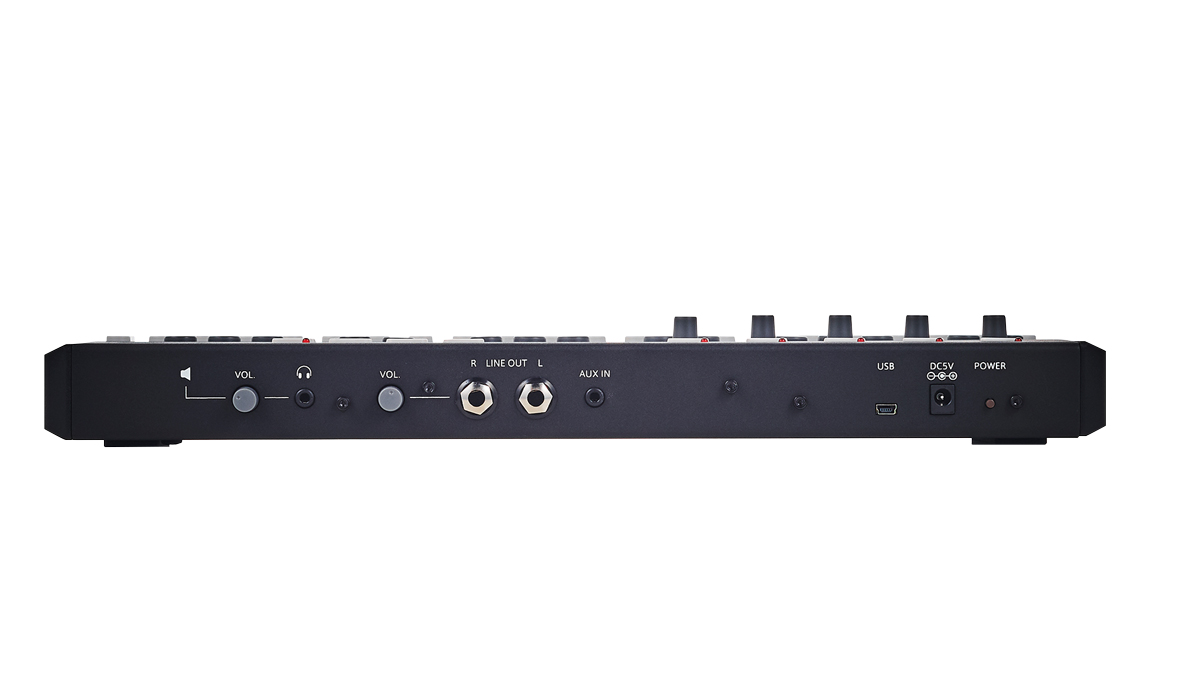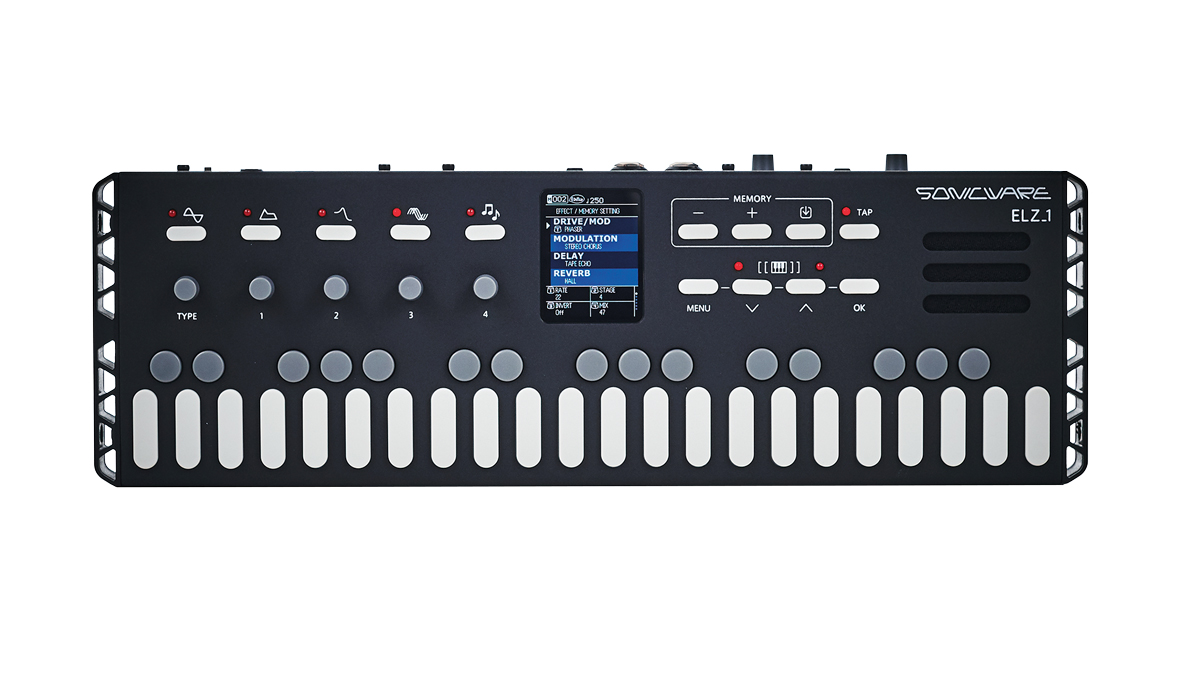MusicRadar Verdict
Interesting, playable and fun. it has some issues, but the upgradable firmware allows for improvements based on user feedback.
Pros
- +
Downloadable firmware updates allow the synth to be continuously tweaked/improved.
Cons
- -
Despite improvements with the latest firmware, modulation capabilities are limited compared to some other synths.
MusicRadar's got your back
There’s currently no shortage of boutique synth gear to lure readers into rash purchases and late night exploration.
Sonicware’s ELZ_1 appeals to just such urges by combining a range of synthesis types within its small, but striking, shell. Most noticeable is its weight - it could take a bump or two. Central to the synth is a small, colourful, OLED screen, with programming buttons and rotary encoders either side. Below this is the ‘keyboard’, a stylised three-octave set of grey and white buttons, that serves the purpose for casual or mobile playing (aided by the built-in speaker and battery power capabilities). The rear panel sports both headphone and line-level (2 x 1/4”) outputs, with independent volume controls, an auxiliary audio input, DC power and (mini) USB connectors (for updates and external interfacing). The latest 2.1 firmware adds a bunch of new features.
The editing system is based on five large editing buttons (where each subsequent keypress moves though the relevant sub-pages), and five encoders mapped to parameters labelled onscreen.

At core, the ELZ_1 features nine different synth engines, all accessed from the main Oscillator button. The simplest building block here is the Standard Osc engine which features a set of simple analogue-style waveshapes. Each has control over its ‘Duty’ (ratio of time taken for the positive versus negative parts of the waveform cycle) for further timbral adjustment. The modulation page allows the Waveform, Duty or Pitch to come under LFO or envelope control. This is a big step on from the version 1 firmware, where things were particularly limited. However, modulation in general on the ELZ is still relatively basic. None of the LFOs can be synced to a master (internal or external) clock, and the ability to retrigger an LFO, use it on multiple parameters, or in parallel with an envelope is not implemented.
Custom Osc adds another level to this engine by allowing you to blend two different wave-shapes cyclically, Low-bit Osc is also broadly similar, but with waves selectable from 8, 4 or 2-bit options. Think old-school computer games.
Next up is the 8-Bit Wavemem Synth that lets you ‘draw’ your own waveshapes into memory. Especially with some detuning (of a parallel oscillator), the results here are reminiscent of ’80s hybrid synths like the Prophet VS or Ensoniq ESQ-1 - not a bad thing. Two additional variants exist for the algorithm. Morph lets you cycle between three of the different wave-shapes sorted in memory, while FM Mode is a quick way of creating and using FM-generated waveforms. All these provide both ‘Modern’ and ‘Classic’ (more aliasing) playback modes.
Besides the wide-ranging sound generation options, the ELZ_1 has an arpeggiator and polyphonic step sequencer in its armoury. The arpeggiator is a pretty conventional affair but comes into its own as part of the ELZ ‘system’. The lo-fi timbres come alive with the arp engaged, with the added benefit that you get more out of the sonic tweaking while it’s playing. The 64-step sequencer is a nice bonus, but requires more user effort. However, Sonicware have crammed all this into a small display, while still making it usable. Both would be useful live - especially given that the synth can now sync to Volca and Pocket Operator devices via the Aux In, as well as via MIDI. However, even for mobile or studio-based work there is much to enjoy here.
However, once again, more modulation destinations other than Pitch would be welcome. Sticking with frequency modulation, FM Synth is a simple four-operator system with 31 different algorithms, and allows control over pitch, detuning and feedback for each operator. Although there’s a modulation section, this only lets you control pitch globally from the dedicated LFO or 4-stage envelope. This lack of per-operator amplitude envelopes means achieving complex DX-style FM sounds is hard. Nonetheless, it is simple and fun - especially when turning the ‘Gacha’ control (named after the lucky-dip toy machine brand) that randomises the FM engine’s parameters.
Want all the hottest music and gear news, reviews, deals, features and more, direct to your inbox? Sign up here.
The next two engines use recorded audio, allowing you to move through it to extract new sonic material. Both are variations on granular synthesis, but with seemingly different ways of managing loop length and other hidden elements. Audio (up to five seconds) can be recorded into the synth via the Aux In, and then stored for subsequent use. This time there are plenty of modulation destinations for the LFO and envelope sources, so quite a bit of flexibility here.
Finally, Masked Noise and Sand Flute use white or pink noise as a starting point. Sand Flute, which uses a series of fixed filters, was particularly good, with some great lo-fi, Fairlight-esque, timbres when using its band-pass filter mode.
Each voice for the selected sound engine is then further shaped by a 4-stage amp envelope and filter section. There are a decent range of filter and EQ types here, though it’s a shame this doesn’t extend to anything more severe than those with a 12dB/octave cutoff. Everything then passes through a multieffects section: good to have, but underwhelming. In fact, we’d keep the distortion effects and swap the rest for a fuller stereo delay implementation.
Overall, the Sonicware ELZ_1 is an interesting synth that takes its own path through the current landscape of portable sequencing synth boxes. It has its flaws, but it’s fun to play, has sonic depth, and may become more powerful as the software matures.
